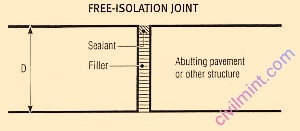Table of Contents
Introduction of Isolation Joint
Isolation joint in concrete structures are a type of separation provided to separate a specific structural member from an adjacent section of a concrete structure to allow relative movement in three directions.

Isolation joint is a type of expansion joint that allow completely independent movement between adjacent structural members.
The American Concrete Institute (ACI) and the Portland Cement Institute (PCI) define an isolation joint as a joint that completely separates one structural unit from another.
Properties of Isolation Joint in Concrete Structures
- Isolation joints are gaps between two concrete structures, like a slab and a wall, that are filled using a preformed joint material for the full depth of the slab. This gap allows the slab to move without disturbing the nearby column or wall.
- Consider a slab surrounding the column footing, separated by an isolation joint, as shown in the figure below. In case of settlement of the column, the slab around is undisturbed or won’t crack. Similarly, plates can expand or contract with temperature changes.
- ACI recommends isolation joints at the junction of slabs and walls, columns, foundations, equipment foundations, and other containment points. The joint materials used for
- Insulated Joints are materials impregnated with foam insulation, plastic, cork, rubber, neoprene, or asphalt.
- A insulated joint is designed and placed in the desired location before the concrete slab is poured. The rebar provided must end at the joint and not pass through it.
- Insulating Joint Filler must be injected to the full depth of the concrete, accommodate expansion and contraction, and allow horizontal and vertical movement.
- Isolation gap width is 1/2 to 1 inch. Large widths can cause excessive movement.
- Insulating Gap Filler penetrates the entire depth of the board, starting at the bottom structure, but not beyond the top.
- For a cleaner look, cut the top of the preformed joint filler and seal the gap with elastomeric sealant.
- Without insulating joints, movement of adjacent elements can cause slabs to crack. A crack in the plate is a weak point that can lead to maintenance and structural problems.
Importance of Isolation Joint
Concrete expands and contracts. When two concrete slabs are poured onto each other, they expand and contract independently and exert forces on each other. This difference in motion can cause concrete to crack. The expansion joint material between the two panels allows this expansion and contraction independently, reducing the chance of cracking. Also note that insulated joints are not only required for injection between slabs. When pouring concrete into structures such as walls and buildings, it is necessary to install thermal insulation joints.
